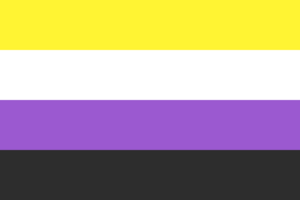Flags

The nonbinary flag is one example of a pride flag.
Flags, or pride flags, are graphic symbols of specific kinds of identities held in common in the MOGII community. This page doesn't have a complete list of all such flags, but includes some flags used elsewhere in this wiki.
Color symbolism[edit | edit source]
Pride flags use color symbolism to describe an identity. Some color symbolism is the same for many different flag designs. Don't think that every flag uses the same color symbolism. Some common color symbolism used in pride flags:
- Pink: means female or femininity.
- Blue: specifically baby blue, means male or masculinity.
- Purple: specifically lavender. As a mix of pink and baby blue pigments, lavender represents a gender that is a mix of female and male, or in between female and male.
- Green: specifically dark chartreuse. As the inverse of the mix of pink and baby blue pigments, this represents a gender that is the opposite or absence of female and male. A neuter gender that is best defined as not male, not female, and not mix of female and male.
- Yellow: Gender that exists outside of and without reference to the binary genders, because it's a primary color not made from pink or blue pigments.
- White: As a mix of all colors of light, this represents many or all genders. However, as an absence of all colors of pigment, this can also mean an absence of gender.
- Black: As a mix of all colors of pigment, this can mean many or all genders. However, as an absence of all colors of light, this can also mean an absence of gender.
- Gray: As a mix of black and white, gray represents partial gender.
- Red: Mainly used to represent passion and life.
- Orange: Represents friendship or semi-romantic bonds.
